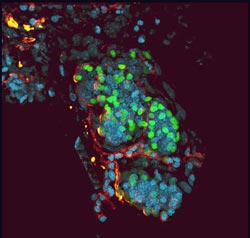USC researcher learns how to break a sweat

Staining of slow-cycling sweat gland cells (green) with the protein laminin (red) and the fluorescent stain DAPI (blue) (Image by Yvonne Leung)<br>
Kobielak and his team used a system to make all of the sweat gland cells in a mouse easy to spot: labeling them with green fluorescent protein (GFP), which is visible under ultraviolet light.
Over time, the GFP became dimmer as it was diluted among dividing sweat gland cells. After four weeks, the only cells that remained fluorescent were the ones that did not divide or divided very slowly — a known property among stem cells of certain tissues, including the hair follicle and cornea. Therefore, these slow-dividing, fluorescent cells in the sweat gland’s coiled lower region were likely also stem cells.
Then, the first author of this paper, graduate student Yvonne Leung, tested whether these fluorescent cells could do what stem cells do best — differentiate into multiple cell types. To the researchers’ surprise, these glowing cells generated not only sweat glands, but also hair follicles when placed in the skin of a mouse without GFP.
The researchers also determined that under certain conditions, the sweat gland stem cells could heal skin wounds and regenerate all layers of the epidermis.
“That was a big surprise for us that those very quiescent sweat gland stem cells maintain multilineage plasticity — participating not only in their own regeneration, but also in the regeneration of hair follicles and skin after injury,” said Kobielak, assistant professor of pathology at the Eli and Edythe Broad Center for Regenerative Medicine and Stem Cell Research at USC.
This offers exciting possibilities for developing future stem cell-based treatments for skin and sweat gland-related conditions, such as hyperhidrosis or hypohidrosis (excessive or insufficient sweating). It could also lay the foundation for creating fully functional skin — containing both sweat glands and hair follicles — for burn victims.
Additional co-authors on the study were Eve Kandyba, Yi-Bu Chen and Seth Ruffins from the Broad Center.
The study was supported by the National Institute of Arthritis and Musculoskeletal and Skin Diseases of the National Institutes of Health (grant numbers R03-AR061028 and R01-AR061552).
Media Contact
More Information:
http://www.usc.eduAll latest news from the category: Life Sciences and Chemistry
Articles and reports from the Life Sciences and chemistry area deal with applied and basic research into modern biology, chemistry and human medicine.
Valuable information can be found on a range of life sciences fields including bacteriology, biochemistry, bionics, bioinformatics, biophysics, biotechnology, genetics, geobotany, human biology, marine biology, microbiology, molecular biology, cellular biology, zoology, bioinorganic chemistry, microchemistry and environmental chemistry.
Newest articles

Silicon Carbide Innovation Alliance to drive industrial-scale semiconductor work
Known for its ability to withstand extreme environments and high voltages, silicon carbide (SiC) is a semiconducting material made up of silicon and carbon atoms arranged into crystals that is…

New SPECT/CT technique shows impressive biomarker identification
…offers increased access for prostate cancer patients. A novel SPECT/CT acquisition method can accurately detect radiopharmaceutical biodistribution in a convenient manner for prostate cancer patients, opening the door for more…

How 3D printers can give robots a soft touch
Soft skin coverings and touch sensors have emerged as a promising feature for robots that are both safer and more intuitive for human interaction, but they are expensive and difficult…





















